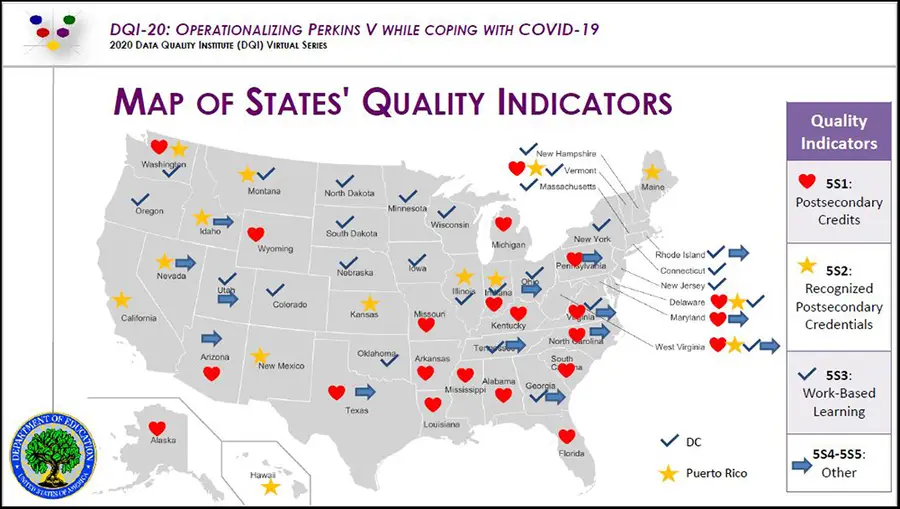Pandemic Presents Implementation Challenges and Opportunities
2020 will be remembered as the year of the global COVID-19 pandemic, but it is also the year that states began to transform their career and technical education (CTE) programs in response to the Strengthening Career and Technical Education for the 21st Century Act (Perkins V), passed in 2018. The year’s unexpected challenge, the COVID-19 pandemic, has also brought significant changes to education of all types. Together, these two events are spurring changes that will shape students’ experiences in career and technical education for years to come.
Through its work with state education agencies, RTI has had an opportunity to learn about how both of these factors are shaping states' approaches to career and technical education and promoting students’ readiness for careers nationwide in expected and unexpected ways. For example, RTI recently convened state CTE staff from across the country during the 2020 Data Quality Institute (DQI) virtual series to discuss how states are operationalizing Perkins V while coping with COVID. Hosted by the Division of Academic Technical Education in the U.S. Department of Education’s Office of Career, Technical, and Adult Education, the DQI is an annual event that brings together CTE staff to discuss and share their plans, innovations, and challenges related to meeting Perkins V federal accountability requirements. RTI also works with up to eight states annually on Perkins V implementation and CTE data quality and reporting through the Customized Technical Assistance to States project, that is funded by the Department of Education.
Through these projects, three themes that are likely to shape CTE in the years to come emerged strongly this fall — expanded stakeholder engagement, new ways to connect students and employers, and new approaches to educator collaboration.
- Expanded stakeholder engagement in career and technical education: Although collaboration between high school and community college CTE programs has long been encouraged by federal and state policy, Perkins V introduced new requirements that have resulted in new and deepened connections between secondary and postsecondary educators. To receive Perkins funds, school districts and colleges are required to conduct comprehensive local needs assessments (CLNA) that evaluate CTE student performance and program quality, including alignment with in-demand industry sectors. As part of the assessment, CTE program leads must consult relevant stakeholders, including representatives from secondary and postsecondary education, the workforce development system, and parents and students, and conduct updates every two years.
COVID-19 restrictions have presented unique challenges for local partners to complete their needs assessments, with one DQI participant stating “It's been difficult for districts and colleges to complete their needs assessments with lack of in-person meetings taking place,” and another noting institutions being “overwhelmed due to remote learning and planning for the upcoming year.” To address these challenges, some states have begun facilitating virtual CLNAs, developed webinars for county teams, and provided the local partners the specific data they need to respond to the application. Although challenging for many, the switch to virtual communications has also helped in some areas, particularly in states with remote and rural areas. The necessity of virtual communications has helped overcome what a state staff member called “virtual resistance,” or stakeholders’ unwillingness to engage via video conference, and has found business leaders who were too busy to attend in-person meetings in the past to be active participants in virtual meetings.
- New options for students to connect with employers: Under Perkins V, each state must choose from among three indicators of program quality for federal accountability reporting: attainment of a recognized postsecondary credential, attainment of postsecondary credits, or participation in work-based learning. The most popular option, work-based learning, was selected by 27 states. In their state plans, many of these states noted that their choice was dictated by stakeholder feedback, and especially employers’ need for graduates familiar with and ready for the professional behavior workplaces require.

COVID-19 restrictions coincided with states’ planning for expanding work-based learning opportunities, increasing interest in online options for work-based learning. Examples include capstone or problem-based projects done virtually under the guidance of employer mentors and online (pre-recorded) tours of workplace facilities or business operations. Some states have also created resources for implementing virtual WBL opportunities, such as guidebooks and templates for designing effective projects in a virtual setting.
Although COVID-19 has accelerated the hunt for alternatives to onsite work-based learning activities, these solutions also have the potential to address longstanding roadblocks to work-based learning access, such transportation needs and regions with low employer density. Based on these experiences, states are exploring future on-site internships with virtual interactions, to allow students and supervisors to get acquainted and ensure that the arrangement is a good fit for both. A number of states have also found some employers more willing to work with students virtually because it solves the need to provide on-site supervision and security concerns.
- New approaches to educator collaboration: Even prior to Perkins V, many states convene their local partners annually to deliver professional development and encourage collaboration around CTE. This year, due to COVID restrictions, states are turning to virtual CTE conferences as an option. While some states were still grappling with this approach, others have actually found that moving online may offer new options to reach stakeholders.
States reported successes in virtual statewide CTE conferences, leading them to consider plans for combined in-person/virtual events in coming years. As one state CTE staff member found, “We transitioned to a virtual experience as opposed to a formal conference. Our attendance was up overall when compared to in-person conferences of the past.” This DQI is another example of how virtual convenings have the potential to attract attendees that in-person events struggle to reach due to attendance limits, the costs of attending, and scheduling conflicts. As an in-person event, the DQI is a 2-day convening held in the Washington D.C. area, and venue size limits attendance to 150 participants, or about 2 to 3 from each state. This year’s eight-session, virtual DQI series was held over a two-month period and attracted over 300 attendees from all 50 states and Washington DC.
As states complete their first year of full implementation of Perkins V, the global pandemic exposed challenges, but also presented opportunities. States are finding innovative ways of expanding stakeholder engagement through virtual, local needs assessments, connecting students and employers, and facilitating educator professional development and collaboration.
How has the new legislative requirements and the COVID-19 pandemic changed CTE in your state? For more information on some of these innovative approaches, and to access all of the DQI series materials, contact us.



